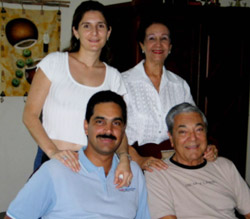|
Doctors Hope to Aid
Dominican Baby with Rare Defect
22nd January 2004

By Jane Sutton MIAMI (Reuters) - An international team of doctors hopes
to operate in the Dominican Republic next month to remove an undeveloped
second head from a baby girl born with one of the world's rarest birth
defects, caused when a conjoined twin fails to develop in the womb.
 The
baby, Rebeca Martinez, was born in mid-December at a hospital in Santo
Domingo with the head of an undeveloped twin attached to the top of her
skull, facing upward. The infant is otherwise healthy but her brain
cannot develop normally unless the undeveloped head is removed, said
Dr. Santiago Hazim, medical director at the CURE International
Center for Orthopedic Specialties, where the surgery is tentatively set
for Feb. 6 or 7. The
baby, Rebeca Martinez, was born in mid-December at a hospital in Santo
Domingo with the head of an undeveloped twin attached to the top of her
skull, facing upward. The infant is otherwise healthy but her brain
cannot develop normally unless the undeveloped head is removed, said
Dr. Santiago Hazim, medical director at the CURE International
Center for Orthopedic Specialties, where the surgery is tentatively set
for Feb. 6 or 7.
Her condition, cranio pagus parasiticus, is so rare that there have only
been eight documented cases in the world, and no known cases where
surgery has been attempted to correct it, Hazim said in a telephone
interview. Conjoined twins form when an embryo begins to split into
identical twins and then stops, leaving them fused. Twins conjoined at
the head account for about one of every 2.5 million births and about 2
percent of all conjoined births. Rarer "parasitic" twins occur when one
conjoined twin stops developing in the womb, leaving a smaller,
incompletely formed twin that is dependent on the other. They can form
as an extra limb, torso or head, or as a complete second body, lacking
vital organs.
In Rebeca's case, there is a gap in her skull where the heads are
joined, and the blood vessels are intertwined, Hazim said. The vestigial
head is enlarged and fringed with dark hair like Rebeca's but has a
poorly developed brain and only rudimentary facial features, he said.
Rebeca was born weighing about 7 pounds and now weighs over 10 pounds,
but the undeveloped head is drawing away nutrients and exerting pressure
on Rebeca's brain.
"She was able to go home after a couple of days in the hospital," Hazim
said. "She's getting some weight on ... She cries, she wakes up in the
morning like a normal child." Dr. Jorge Lazareff, director of pediatric
neurosurgery at UCLA's Mattel Children's Hospital, will lead a team of
doctors traveling to Santo Domingo this weekend to examine Rebeca, meet
with her parents and decide whether to proceed with the surgery.
"We want to do it, we believe it has to be done ... but the actual
decision of going ahead, there is no actual decision," said Lazareff,
who led the medical team that successfully separated Guatemalan twin
girls joined at the head in 2002.
Two teams, each with nine volunteer doctors, would carry out the
operation, working in 12-hour shifts. Doctors would decide during the
surgery whether to try closing Rebeca's skull using bone from the other
skull. Otherwise, they would try to close it later using bone from a
donor bank or a metal plate, Hazim said. "It will depend on what we
find," he said. "We haven't found one (case) like this in the literature
that has been done. I believe this is going to be the first one."
Her parents Maria Gisela Hiciano, 26, and Franklyn Martinez, 28, earn
only $200 a month and cannot pay for her medical care. The doctors are
volunteering their services. The hospital where the surgery will take
place is operated by CURE International, a nonprofit organization
headquartered in Pennsylvania, that provides medical and spiritual care
for disabled children in developing nations.
Picture showing Dr.
Santiago Hazim and wife Maribel with Parents Don Johnny and Donia
Yamili.

|
|